Estimation of Foot Trajectory and Stride Length during Level Ground Running Using Foot-Mounted Inertial Measurement Units
Abstract
:1. Introduction
2. Materials and Methods
2.1. Data Collection and Processing
2.2. Foot Trajectory Estimation
2.2.1. Spatial Error Correcting (SEC) Method
2.2.2. Linear Dedrifting (LD) Based on the Velocity Method
2.3. Evaluation
3. Results
4. Discussion
Author Contributions
Funding
Institutional Review Board Statement
Informed Consent Statement
Data Availability Statement
Acknowledgments
Conflicts of Interest
References
- Paquette, M.R.; Melcher, D.A. Impact of a long run on injury-related biomechanics with relation to weekly mileage in trained male runners. J. Appl. Biomech. 2017, 33, 216–221. [Google Scholar] [CrossRef]
- Mo, S.; Chow, D.H.K. Accuracy of three methods in gait event detection during overground running. Gait Posture 2018, 59, 93–98. [Google Scholar] [CrossRef] [PubMed]
- Benson, L.; Clermont, C.; Watari, R.; Exley, T.; Ferber, R. Automated Accelerometer-Based Gait Event Detection during Multiple Running Conditions. Sensors 2019, 19, 1483. [Google Scholar] [CrossRef] [PubMed]
- Aubol, K.G.; Milner, C.E. Foot contact identification using a single triaxial accelerometer during running. J. Biomech. 2020, 105, 109768. [Google Scholar] [CrossRef] [PubMed]
- Rebula, J.R.; Ojeda, L.V.; Adamczyk, P.G.; Kuo, A.D. Measurement of foot placement and its variability with inertial sensors. Gait Posture 2013, 38, 974–980. [Google Scholar] [CrossRef]
- Chew, D.; Ngoh, K.J.; Gouwanda, D.; Gopalai, A.A. Estimating running spatial and temporal parameters using an inertial sensor. Sports Eng. 2018, 21, 115–122. [Google Scholar] [CrossRef]
- Potter, M.V.; Ojeda, L.V.; Perkins, N.C.; Cain, S.M. Effect of IMU Design on IMU-Derived Stride Metrics for Running. Sensors 2019, 19, 2601. [Google Scholar] [CrossRef]
- Veltink, P.H.; Slycke, P.; Hemssems, J.; Buschman, R.; Bultstra, G.; Hermens, H. Three dimensional inertial sensing of foot movements for automatic tuning of a two-channel implantable drop-foot stimulator. Med. Eng Phys. 2003, 25, 21–28. [Google Scholar] [CrossRef]
- Ojeda, L.; Borenstein, J. Non-GPS Navigation for Security Personnel and First Responders. J. Navigat. 2007, 60, 391–407. [Google Scholar] [CrossRef]
- Li, Q.; Young, M.; Naing, V.; Donelan, J.M. Walking speed estimation using a shank-mounted inertial measurement unit. J. Biomech. 2010, 43, 1640–1643. [Google Scholar] [CrossRef]
- Peruzzi, A.; Della Croce, U.; Cereatti, A. Estimation of stride length in level walking using an inertial measurement unit attached to the foot: A validation of the zero velocity assumption during stance. J. Biomech. 2011, 44, 1991–1994. [Google Scholar] [CrossRef]
- Mariani, B.; Hoskovec, C.; Rochat, S.; Büla, C.; Penders, J.; Aminian, K. 3D gait assessment in young and elderly subjects using foot-worn inertial sensors. J. Biomech. 2010, 43, 2999–3006. [Google Scholar] [CrossRef]
- Yang, S.; Mohr, C.; Li, Q. Ambulatory running speed estimation using an inertial sensor. Gait Posture 2011, 34, 462–466. [Google Scholar] [CrossRef]
- Rampp, A.; Barth, J.; Schulein, S.; Gassmann, K.G.; Klucken, J.; Eskofier, B.M. Inertial sensor-based stride parameter calculation from gait sequences in geriatric patients. IEEE Trans. Biomed. Eng. 2015, 62, 1089–1097. [Google Scholar] [CrossRef]
- Zrenner, M.; Gradl, S.; Jensen, U.; Ullrich, M.; Eskofier, B.M. Comparison of Different Algorithms for Calculating Velocity and Stride Length in Running Using Inertial Measurement Units. Sensors 2018, 18, 4194. [Google Scholar] [CrossRef]
- Luinge, H.J.; Veltink, P.H. Measuring orientation of human body segments using miniature gyroscopes and accelerometers. Med. Biol. Eng. Comput. 2005, 43, 273–282. [Google Scholar] [CrossRef]
- Woltring, H.J. A Fortran package for generalized, cross-validatory spline smoothing and differentiation. Adv. Eng. Softw. 1986, 8, 104–113. [Google Scholar] [CrossRef]
- Glowinski, S.; Krzyzynski, T.; Bryndal, A.; Maciejewski, I. A Kinematic Model of a Humanoid Lower Limb Exoskeleton with Hydraulic Actuators. Sensors 2020, 21, 6116. [Google Scholar] [CrossRef]
- Nilsson, J.O.; Skog, I.; Händel, P. A note on the limitations of ZUPTs and the implications on sensor error modeling. In Proceeding of the IEEE International Conference on Indoor Positioning and Indoor Navigation, Sydney, Australia, 13–15 November 2012; pp. 1–4. [Google Scholar]
- Park, S.K.; Suh, Y.S. A zero velocity detection algorithm using inertial sensors for pedestrian navigation systems. Sensors 2010, 10, 9163–9178. [Google Scholar] [CrossRef]
- Baileya, G.P.; Harlea, R. Assessment of Foot Kinematics During Steady State Running Using a Foot-Mounted IMU. Procedia Eng. 2014, 72, 32–37. [Google Scholar] [CrossRef] [Green Version]
- Zrenner, M.; Küderle, A.; Roth, N.; Jensen, U.; Dümler, B.; Eskofier, B.M. Does the Position of Foot-Mounted IMU Sensors Influence the Accuracy of Spatio-Temporal Parameters in Endurance Running? Sensors 2020, 20, 5705. [Google Scholar] [CrossRef] [PubMed]


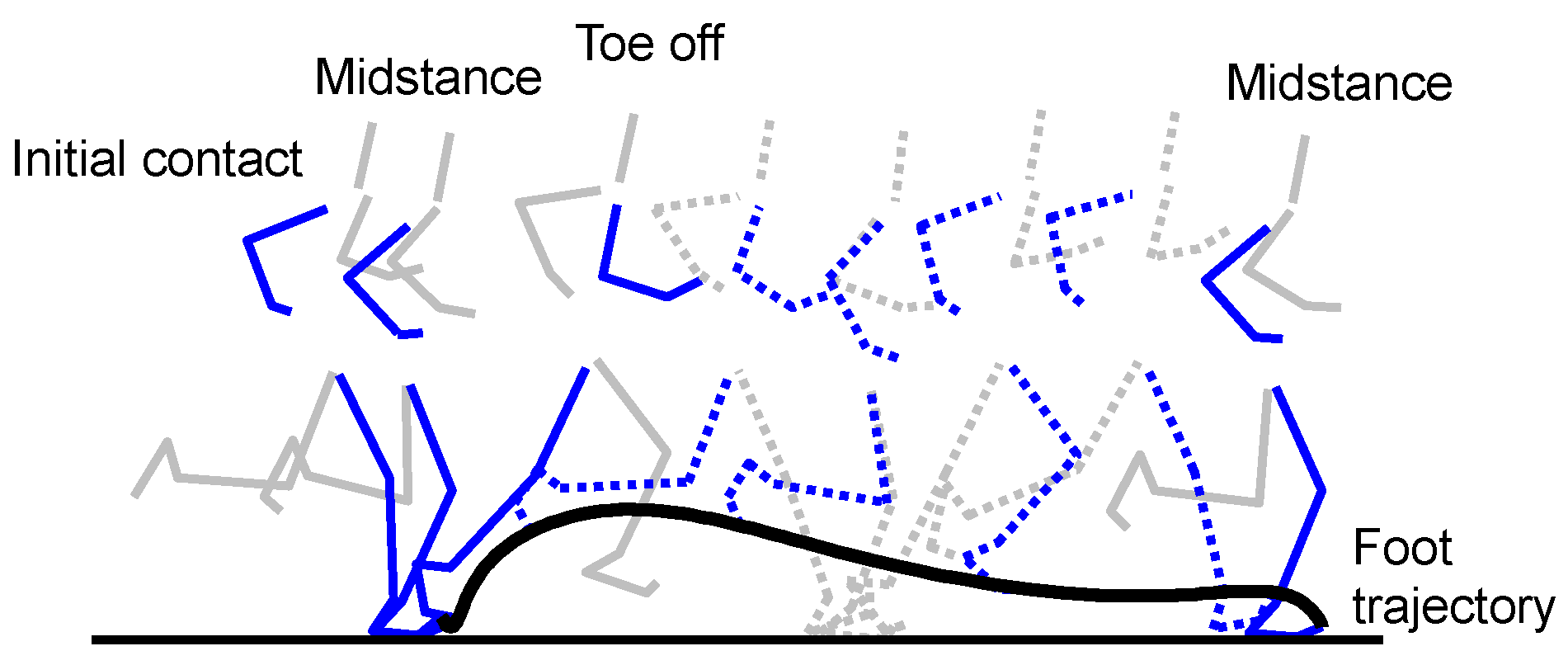
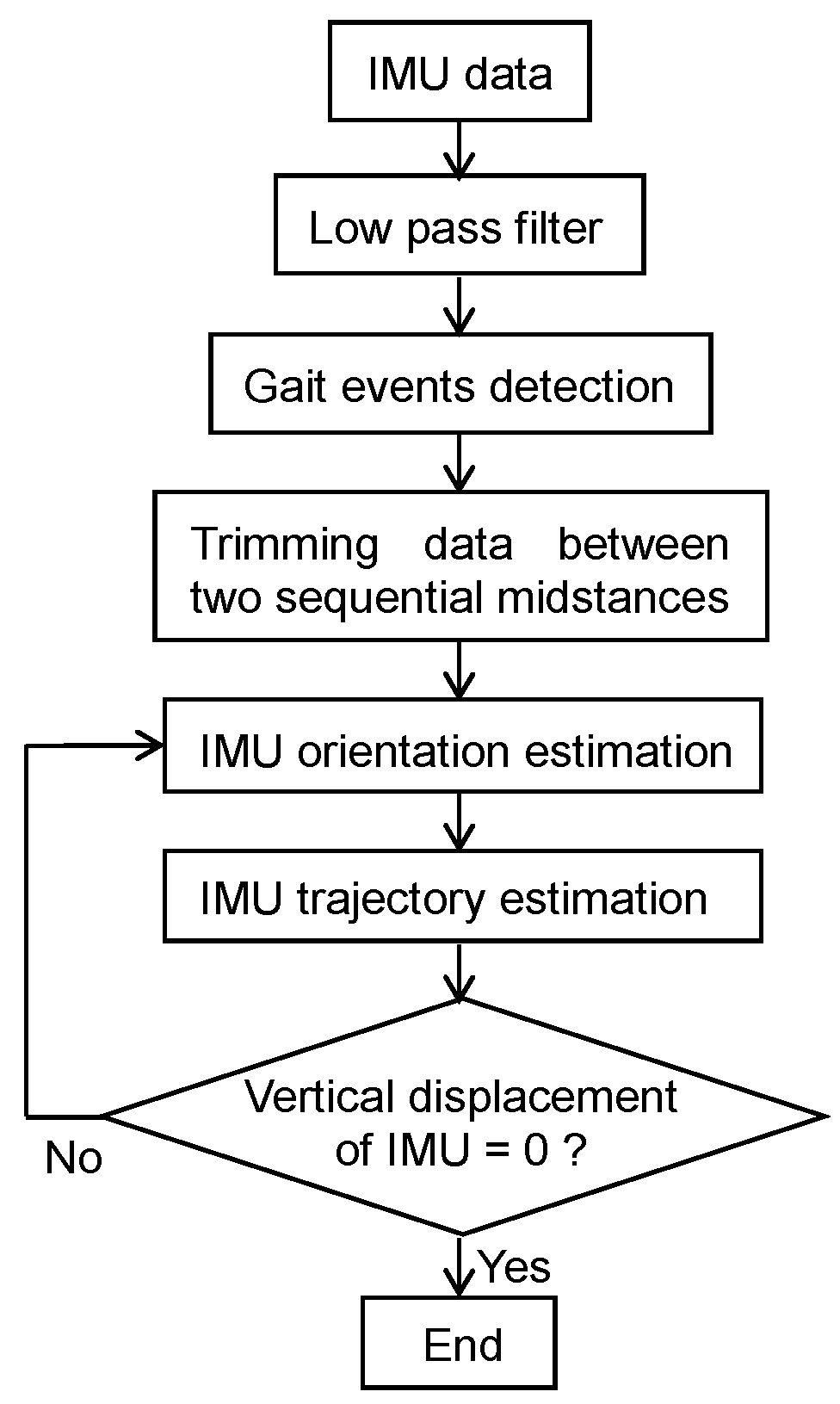
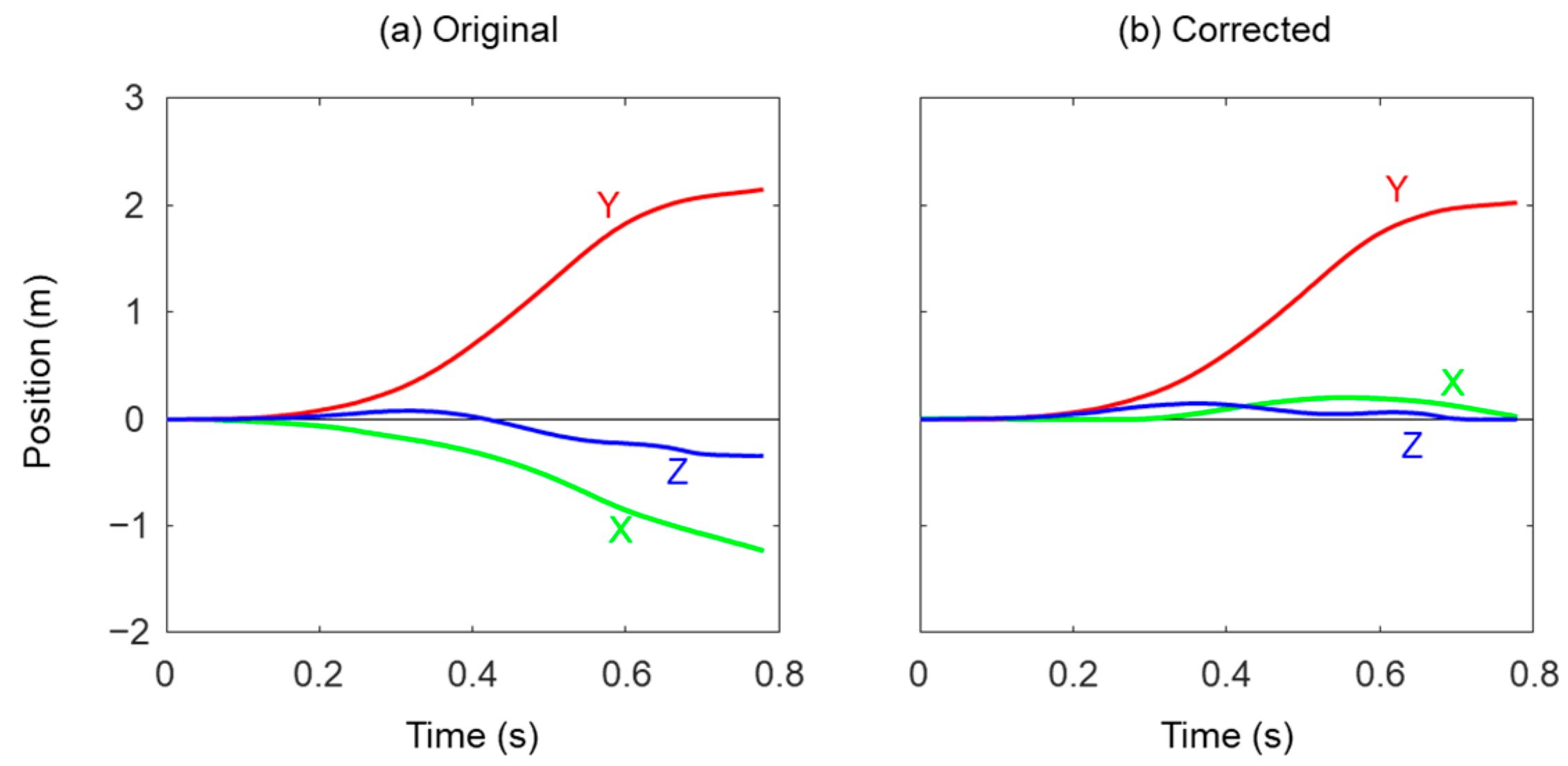


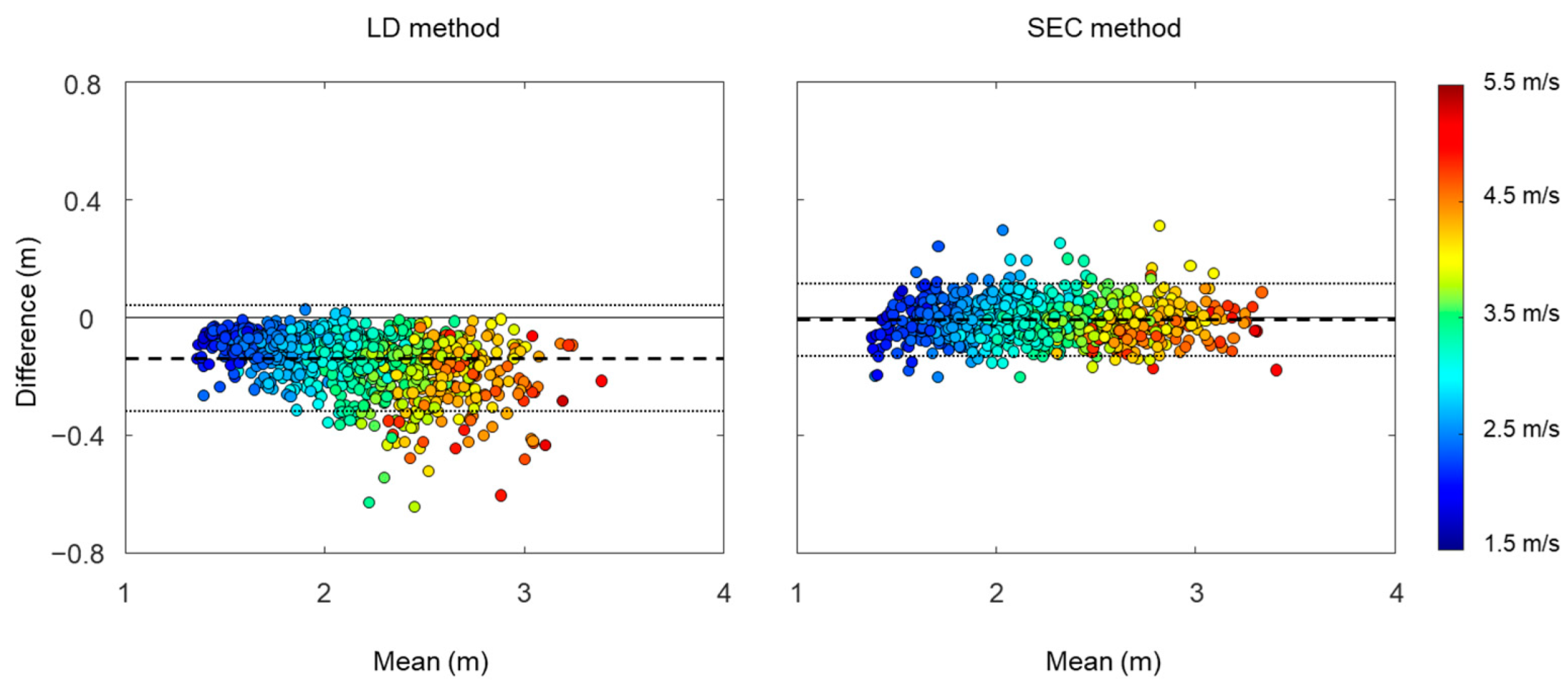
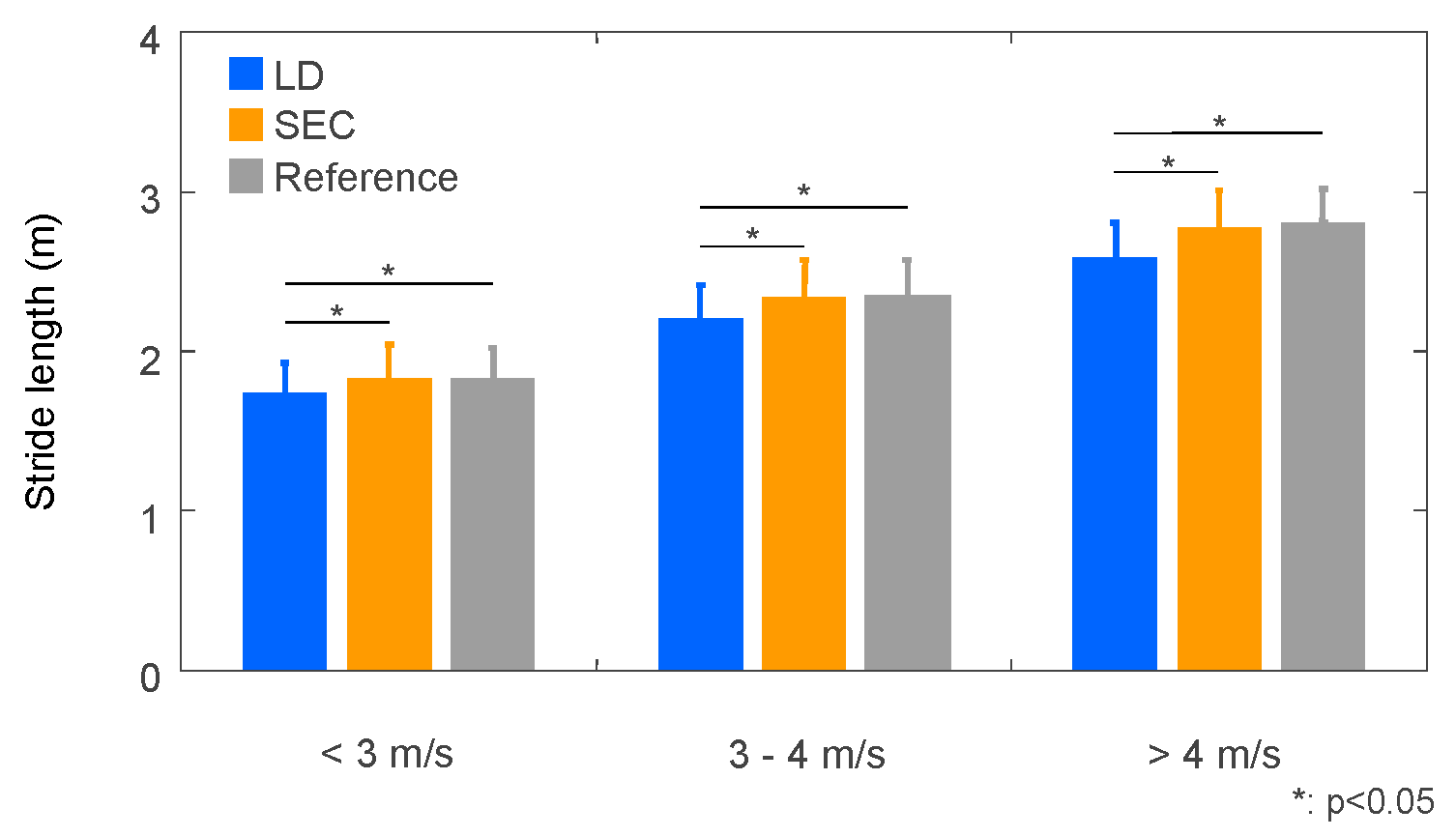
| N | Age (Years) | Height (m) | Mass (kg) | |
|---|---|---|---|---|
| Female | 22 | 40.7 ± 12.6 | 1.59 ± 0.05 | 49.9 ± 4.7 |
| Male | 57 | 35.1 ± 13.9 | 1.70 ± 13.9 | 61.3 ± 6.8 |
| Running Speed (m/s) | Number of Trials |
|---|---|
| <2.7 m/s | 87 |
| 2.7~3.3 m/s | 102 |
| 3.3~3.9 m/s | 95 |
| 3.9~4.5 m/s | 101 |
| >4.5 m/s | 26 |
| X | Y | Z | |
|---|---|---|---|
| Correlation coefficient | |||
| LD | 0.06 ± 0.48 | 0.99 ± 0.00 | 0.56 ± 0.27 |
| SEC | 0.48 ± 0.44 | 1.00 ± 0.00 | 0.97 ± 0.08 |
| Root mean square error (m) | |||
| LD | 0.26 ± 0.17 | 0.17 ± 0.11 | 0.24 ± 0.20 |
| SEC | 0.06 ± 0.04 | 0.05 ± 0.02 | 0.03 ± 0.01 |
| LD Method | SEC Method | |||
|---|---|---|---|---|
| Error | Abs. Error | Error | Abs. Error | |
| <3 m/s | −0.05 ± 0.03 * | 0.05 ± 0.03 * | 0.00 ± 0.03 | 0.03 ± 0.02 |
| 3–4 m/s | −0.06 ± 0.04 * | 0.06 ± 0.04 * | −0.01 ± 0.03 | 0.02 ± 0.02 |
| >4 m/s | −0.08 ± 0.04 * | 0.08 ± 0.04 * | −0.01 ± 0.02 | 0.02 ± 0.01 |
| LD Method | SEC Method | |||
|---|---|---|---|---|
| ICC (3, 1) | CI of ICC | ICC (3, 1) | CI of ICC | |
| <3 m/s | 0.957 | [0.949–0.963] | 0.952 | [0.944–0.959] |
| 3–4 m/s | 0.912 | [0.897–0.925] | 0.961 | [0.954–0.967] |
| >4 m/s | 0.878 | [0.847–0.903] | 0.968 | [0.959–0.975] |
Publisher’s Note: MDPI stays neutral with regard to jurisdictional claims in published maps and institutional affiliations. |
© 2022 by the authors. Licensee MDPI, Basel, Switzerland. This article is an open access article distributed under the terms and conditions of the Creative Commons Attribution (CC BY) license (https://creativecommons.org/licenses/by/4.0/).
Share and Cite
Suzuki, Y.; Hahn, M.E.; Enomoto, Y. Estimation of Foot Trajectory and Stride Length during Level Ground Running Using Foot-Mounted Inertial Measurement Units. Sensors 2022, 22, 7129. https://doi.org/10.3390/s22197129
Suzuki Y, Hahn ME, Enomoto Y. Estimation of Foot Trajectory and Stride Length during Level Ground Running Using Foot-Mounted Inertial Measurement Units. Sensors. 2022; 22(19):7129. https://doi.org/10.3390/s22197129
Chicago/Turabian StyleSuzuki, Yuta, Michael E. Hahn, and Yasushi Enomoto. 2022. "Estimation of Foot Trajectory and Stride Length during Level Ground Running Using Foot-Mounted Inertial Measurement Units" Sensors 22, no. 19: 7129. https://doi.org/10.3390/s22197129





